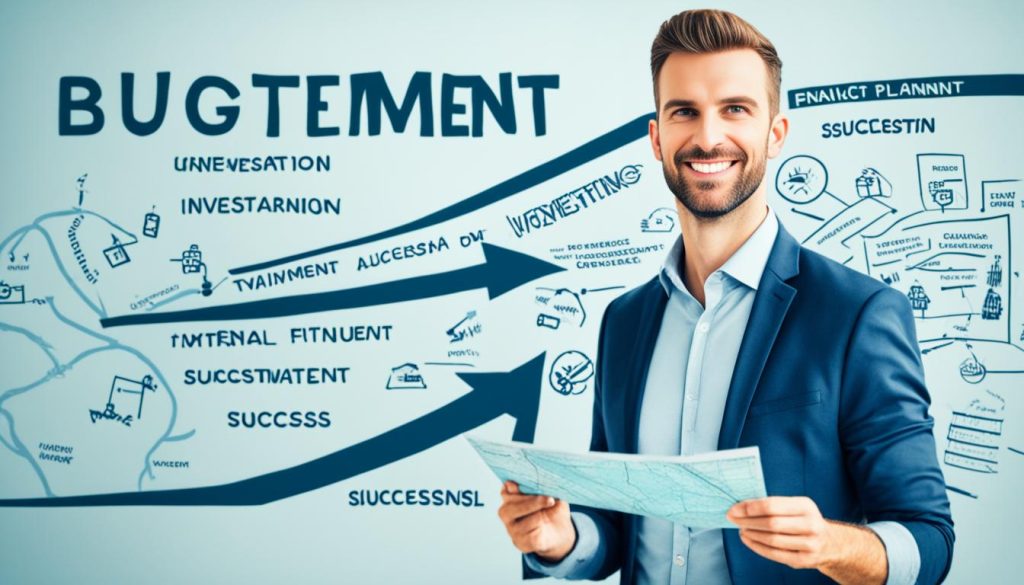Early retirement needs careful financial planning and a strong commitment. Only half of Americans know how much they need to save for retirement1. The average American spends about 20 years in retirement1. It’s vital to start saving and keep to your retirement goals early. Over a quarter of workers with a retirement plan don’t even join it1.
Retiring early means funding your retirement yourself. You can get Social Security at 62, but your monthly benefits will be less2. You need a detailed retirement plan. Think about when you want to retire, your lifestyle, income, living costs, and future plans. This plan might include increasing your income, saving for emergencies, paying off debt, and setting up an estate plan.
Key Takeaways
- Preparing for early retirement requires careful financial planning and commitment.
- Only about half of Americans have calculated their retirement savings needs.
- The average American spends 20 years in retirement, making it crucial to start saving early.
- Retiring early means self-funding your retirement since Social Security benefits are reduced if claimed before full retirement age.
- Develop a comprehensive retirement plan that considers your timing, lifestyle, income, expenses, and future planning.
What is Early Retirement and Why Plan for It?
Early retirement is about getting financially free to choose when and how you work. It’s part of the FIRE (Financial Independence, Retire Early) movement3. People in FIRE save a lot to live off less, aiming to retire way before the usual age3.
Understanding the FIRE Movement
The FIRE movement is all about saving and investing a lot, up to 50-75% of your income, to retire early3. It’s about getting financially free in your 30s or 40s through careful money management3. Using brokerage accounts and mutual funds with low turnover is key to this strategy3.
Benefits of Retiring Early
Retiring early means you can do what you love, travel, and live life on your terms4. But, you need to fund your retirement yourself since you can start getting reduced Social Security at 624. Making lifestyle changes and possibly getting a second job can help you reach your early retirement goals5.
Setting clear retirement goals, making a budget, and talking with a financial advisor are key steps to early retirement5. It’s vital to check your finances before planning for early retirement for a solid plan3.
“Early retirement is possible by living simply, investing wisely, and planning for the future. Compound interest helps you need less money now, making it easier to retire early.”5
Start Saving and Stick to Your Retirement Goals
Saving for retirement is crucial, no matter your age6. It’s never too soon or too late to plan for your future. Create a plan, set clear goals, and follow them closely6.
Calculating Your Retirement Needs
Many people planning for early retirement aim to live on half their current income. This money goes into savings7. To figure out what you need, think about your yearly costs. Include things like housing, utilities, healthcare, and fun activities8.
Your retirement money might come from superannuation, the Age Pension, and your savings8. Experts suggest putting 10% of your income into retirement savings, like 401(k)s6. Some employers might even match what you put in, doubling your savings7. If you’re 50 or older, you can add more to IRAs and 401(k)s678.
Planning for retirement means thinking about your lifestyle, like hobbies and travel6. Your plan should include future costs, debts, and how long you expect to live8.
It’s never too soon or too late to start saving for retirement. By setting clear goals, managing your budget, and having different income sources, you can have a secure and happy early retirement678.
How to Financially Prepare for Early Retirement
Getting ready for early retirement means careful planning and sticking to a budget. It’s important to learn how to manage your money well. This includes budgeting, cutting expenses, and making smart investment choices9.
Budgeting and Expense Reduction Tactics
First, take a close look at how you spend your money. Find ways to spend less, like paying off debt, living in a smaller place, or saving on bills and groceries9. Try to save 50-70% of your income to retire early faster, a common goal for FIRE followers9.
Also, set up automatic savings and investments to keep adding money to your retirement fund10. Using credit cards with no interest for a while can also cut down on debt costs11.
Investment Strategies for Early Retirement
Having a mix of investments is crucial for early retirement11. Think about low-cost index funds for a broad market reach and good long-term growth11. You might also consider a gold IRA for stability during tough economic times11.
It’s also key to plan your withdrawals wisely. The 4% rule is a good starting point, adjusting for inflation over time1110. Getting advice from a financial advisor can also help make your retirement savings last longer1110.
Early retirement needs a well-rounded plan. By being smart with your budget and investments, you can greatly boost your chances of a secure early retirement91110.
Maximize Retirement Accounts and Tax Efficiency
To boost your retirement savings, use tax-advantaged accounts like 401(k)s and IRAs12. These accounts let you put in money before or after taxes. This money grows without taxes until you retire13. Roth IRAs are special because you can take out your money anytime without penalties13.
But, watch out for early withdrawal penalties12. Taking money out of most retirement accounts before age 59 1/2 can cost you a 10% penalty, plus you’ll pay taxes on it12. To avoid these costs, talk to a financial expert. They can help plan your withdrawals to save more.
| Tax-Advantaged Retirement Accounts | Key Benefits |
|---|---|
| 401(k) and Traditional IRA |
|
| Roth IRA and Roth 401(k) |
|
| Health Savings Account (HSA) |
|
Using these tax-advantaged accounts wisely can lower your taxes and grow your retirement savings13. Always work with a financial expert. They can help you use your money wisely and avoid early withdrawal penalties12.
Passive Income Sources and Side Hustles
Planning for early retirement? Exploring passive income sources and side hustles can change the game. Passive income lets you earn money with little effort14. It can boost your wealth, help you retire early, protect you from job loss, and give you extra cash in retirement14. Some top passive income ideas are real estate, rental properties, blogs, e-books, online courses, stock photos, and custom products14. High-yield savings accounts are also a way to earn passive income14.
Building Multiple Income Streams
It’s key to diversify your income when aiming for early retirement. Renting out properties, hosting Airbnb guests, and storing items can be good passive income ideas14. Renting out sports gear, tools, vehicles, and recreational equipment can also bring in money14. Starting a blog or YouTube channel and selling ads or products can create passive income too14. Writing e-books, creating guides, and designing custom products for sale online can also be profitable14. Selling stock photos, music, and artwork online can help as well14.
Passive income is great for making extra cash, especially when prices are high15. It adds security and helps you save for retirement15. The IRS says passive income is earnings from a source not related to a job or contractor work, like rental properties or a business you don’t actively work in15. Some top passive income ideas include making a course, writing an e-book, rental income, affiliate marketing, and flipping products15.
Since 1999, passive income has helped people retire early16. In 2012, it made about $80,000, and by later years, it was around $380,00016. The person saved 50-75% of their income for 13 years to build this passive income16. Now, they save about 50% and earn more through a personal finance site16.
By creating various passive income sources and side hustles, you can lessen the need to use your retirement savings. Diversifying your income can be a strong strategy as you move towards early retirement. Whether it’s through rental properties, online courses, or freelance work, it’s a powerful way to increase your financial security.
Early Retirement Calculators and Planning Tools
Starting your early retirement journey? Using retirement calculators and planning tools is key. They help you figure out how much you need to save, predict your income, and check if your savings will last17.
A top early retirement calculator helps you see when you can retire. It looks at your income, spending, and growth rate, along with your retirement costs and investments17. It suggests a 4% withdrawal rate from your savings, adjusted for inflation17. You can choose from three ways to estimate your investment returns: fixed, historical, or Monte Carlo simulation17.
Another tool splits retirement into two parts: a “Bridge” phase and a second phase with extra income18. It assumes steady investment returns and inflation, ignoring taxes and unknowns18. Yet, it looks at different ways to plan for retirement, like waiting to claim Social Security18.
Remember, many Americans aren’t saving enough for retirement19. Experts say you’ll need 70% of your pre-retirement income from various sources19. Saving early can really help, as just $89 more a month can cover a big retirement gap19.
These early retirement tools help you check if you’re ready, try out different scenarios, and make smart choices. They ensure you can enjoy a secure and fulfilling early retirement171819.
“Successful retirement planning involves setting goals, adapting to unforeseen circumstances, and using tools like retirement calculators to assess progress towards objectives.”19
Conclusion
Getting ready for early retirement means having a solid financial plan and sticking to it over time. It’s important to save, invest, and manage your expenses wisely. Key steps include learning about the FIRE movement, figuring out how much you need for retirement, and cutting costs20.
To boost your chances of retiring early, make the most of tax-friendly retirement accounts. Also, look into passive income and side jobs. Using retirement calculators and getting advice from financial experts can help a lot too2122.
This article has shown how crucial careful planning, saving, and focusing on the future are. By doing these things, you can work towards an early retirement. This way, you can live a happy and financially secure life later on.
FAQ
What is the FIRE movement and how does it relate to early retirement?
What are the benefits of retiring early?
How can I calculate my retirement needs?
What strategies can I use to reduce expenses and save more for early retirement?
How can I maximize my retirement savings and investments?
How can I generate passive income or take on side hustles to supplement my early retirement savings?
What tools and resources can I use to plan for early retirement?
Source Links
- Top 10 Ways to Prepare for Retirement
- Early Retirement: A Step-By-Step Guide And Calculator – NerdWallet
- How to Retire Early: Everything You Need to Know
- How to Retire Early
- Guide To Early Retirement
- What Is Retirement Planning? Steps, Stages, and What to Consider
- 10 Different Ways to Help You Boost Your Retirement Savings
- Essential steps for retirement planning
- How to Retire Early in Six Steps
- How to Retire Early: Steps, Strategies & Savings | The Motley Fool
- Want to retire early? Make these 5 moves in 2024
- Tax Strategies for Your Retirement Income
- How to Plan Ahead for Taxes in Retirement
- 15 Passive Income Ideas to Build Wealth in 2024
- 25 Passive Income Ideas To Help You Make Money In 2024 | Bankrate
- How To Build Passive Income For Financial Independence
- FIRE Calculator: When can I retire early? – Engaging Data
- Early Retirement Calculator – Withdrawals and Income
- Retirement Calculator – See How Much You’ll Need to Retire
- Early Retirement: The Pros and (Mostly) Cons
- Financial steps for getting ready for retirement
- Thinking About Retiring Early? | Carson Wealth



